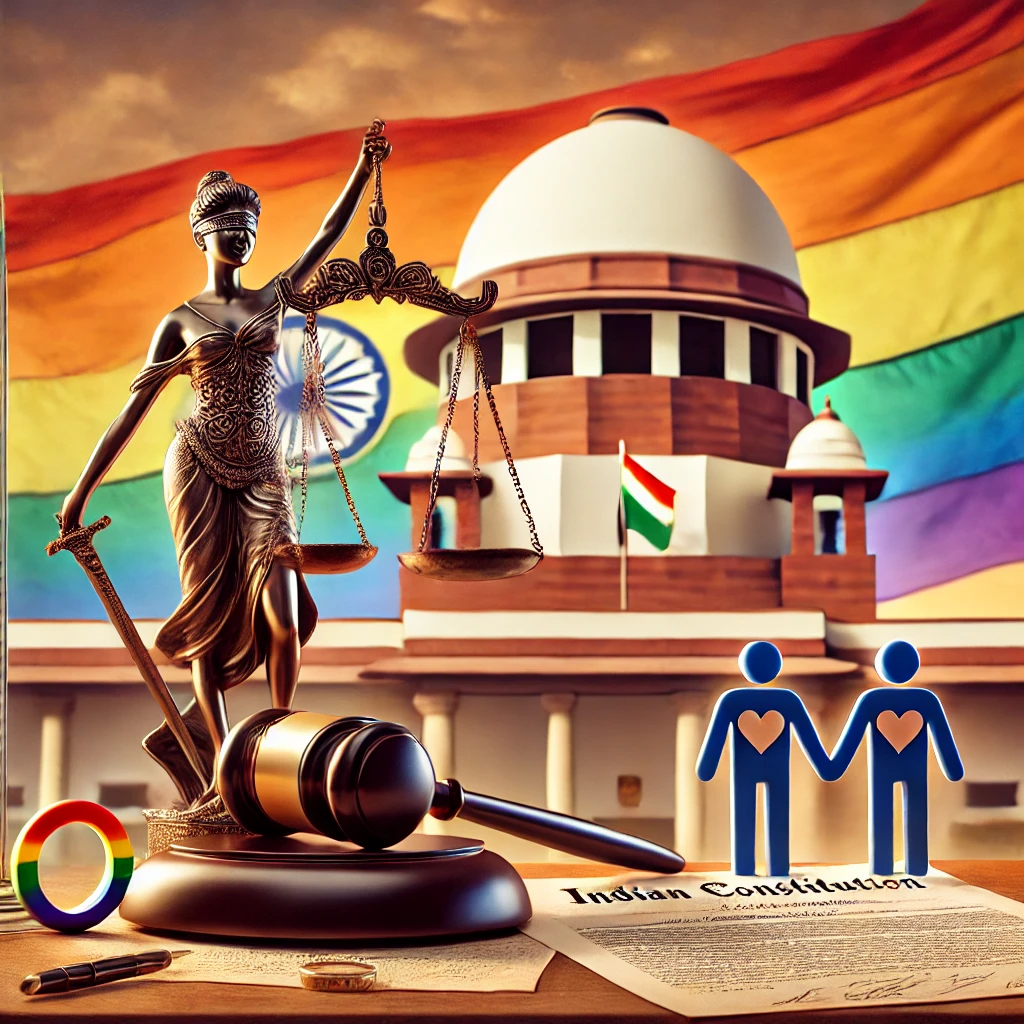
Likitha Sri Meka, a 3rd year student pursuing BBA LLB from Symbiosis Law School, Hyderabad, Read More.

Abstract
This article critically examines the legal landscape of same-sex marriages in India, focusing on constitutional provisions, judicial precedents, and evolving societal perspectives. The objective is to analyze whether the Indian legal framework supports the recognition of same-sex marriages within the ambit of constitutional guarantees such as equality (Article 14)[1], non-discrimination (Article 15)[2], and the right to life and personal liberty (Article 21)[3]. Its scope includes an examination of relevant case laws such as Navtej Singh Johar v. Union of India[4] and Shafin Jahan v. Asokan K.M.[5] to analyze the progressive actions of the judiciary vis–vis the issue of individual autonomy and privacy. It shall be done through doctrinal analysis of statutes and constitutional principles and, for further insight, comparative insights from jurisdictions that recognize same-sex marriages. Key findings reveal a tension between societal conservatism and the judiciary’s push for inclusivity. Proponents argue that denying recognition violates fundamental rights, perpetuates stigma, and hinders access to marital benefits, while opponents cite cultural and religious objections, asserting that marriage traditionally exists only between a man and a woman. Finally, it concludes with an appeal for a balanced approach in urging that recognizing same-sex marriages accords with constitutional values and worldwide trends but still calls for sensitization of the society and legislation to achieve better acceptance and clarity in law.
Keywords: Same-sex marriage, Constitution of India, LGBTQ+ rights, Article 14, Article 21
Introduction
Context and Relevance
The socio-legal background of same-sex relationships in India has undergone a significant transformation, particularly in the aftermath of the landmark Supreme Court judgment in Navtej Singh Johar v. Union of India (2018). This judgment decriminalized consensual same-sex relationships by reading down Section 377 of the Indian Penal Code, a colonial-era law criminalizing “unnatural offenses.” It was a watershed moment as it recognized the inherent dignity, autonomy, and equality of LGBTQ+ individuals under Articles 14, 15, and 21 of the Constitution. Although the judgment is a step in dismantling institutional discrimination, Indian law still does not recognize same-sex marriages. As a result, most LGBTQ+ couples do not enjoy inheritance, adoption, and spousal rights, reflecting the deep conservatism in society and showing how constitutional ideals and societal acceptance diverge. This debate about same-sex marriages therefore raises important questions about the interface between personal liberties, cultural values, and legal reforms in a fast-changing socio-political scenario.
Objectives of the Article
It deals with the Constitutional and Legal Structure applicable to same-sex marriages in India. It deals with judicial construction and principles supporting marriage as a fundamental right focusing on the Articles 14, 15, and 21. The case laws and major arguments for and against the legality of same-sex marriages are scrutinized to deduce how Constitutional values can play a bridge over the societal mainstream and legal law.
Constitutional Principle
Right to Equality (Article 14)
Article 14 of the Constitution of India talks about equality before the law, and equal protection under the laws of the land. This means no person or group should be subject to arbitrary discrimination by the State. The situation of same-sex marriages being given no legal existence is a contradiction of this constitutional right, denying them a ‘justifiably different’ reason for exclusion due to sexual preference. The Supreme Court in Navtej Singh Johar v. Union of India (2018) held that equality not only includes formal equality but also substantive equality to ensure that marginalized groups are provided with the same legal protection as others. Same-sex marriages would, therefore, be in accordance with Article 14, which requires the elimination of discriminatory barriers and equal access to marital rights and benefits.
Right to Life and Personal Liberty (Article 21)
Article 21 of the Constitution refers to the right to life and personal liberty that is expansively interpreted, embracing the right to marry. As held in the case Lata Singh v. State of Uttar Pradesh (2006)[6], such choices of life partner by a citizen above an age of maturity constitute personal liberties to be ably protected, with no allowance whatsoever for their restraint by reason of societal and/or family sentiments. This argument can be further extended that the right to marry, being a part of personal liberty, should also extend to same-sex couples. Their denial of this right violates their autonomy and dignity as marriage is an important component of a person’s personal and social identity.
Anti-Discrimination Provisions (Article 15)
Article 15 prohibits discrimination on grounds of religion, race, caste, sex, or place of birth. The Supreme Court in Navtej Singh Johar recognized sexual orientation as an intrinsic aspect of an individual’s identity, thereby falling within the ambit of “sex” under Article 15. Discriminatory denial of same-sex marriages perpetuates systemic exclusion and reinforces stereotypes, violating this anti-discrimination guarantee. Ensuring marriage equality would affirm the state’s obligation to protect all citizens from discrimination and promote inclusivity in line with constitutional values.
Judicial Decisions
Decriminalization of Homosexuality (Navtej Singh Johar v. Union of India, 2018)
The Supreme Court’s judgment in Navtej Singh Johar v. Union of India (2018) marked a historical juncture for LGBTQ+ rights in India. The Court interpreted the Indian Penal Code and read down Section 377 of the Indian Penal Code, criminalizing consensual same-sex relations, thus decriminalizing homosexuality. This was a decision rooted in the very principles of equality under Article 14, right to privacy under Article 21, and freedom from discrimination under Article 15. The judgment further established that criminalization of homosexuality violates the dignity and autonomy of LGBTQ+ persons and that consenting sexual relations between adults in private should not be subjected to state sanction. The judgment energized the wider LGBTQ+ rights movement in India: the law must protect rights for sexual minorities and should evolve with constitutional values of equality and liberty. However, even though homosexuality is no longer penalizable, it remains to be seen that same-sex marriages are legally recognized, reinforcing the need for judicial and legislative reforms in this regard.
Right to Privacy and Dignity (Justice K.S. Puttaswamy v. Union of India, 2017)
The landmark decision in Justice K.S. Puttaswamy v. Union of India (2017)[7], which recognized the fundamental right to privacy as part of the right to life and personal liberty under Article 21, further advanced the cause of LGBTQ+ rights in India. The Court underlined the fact that privacy is an intrinsic part of human dignity and autonomy and that individuals must be allowed to make choices about their relationship life, immune to state actions. This decision paved the way for many other judgments subsequently, including Navtej Singh Johar, that personal choices, such as the choice of a life partner, are covered under privacy. The recognition of privacy has direct implications for the right of LGBTQ+ individuals to engage in same-sex relationships and seek marriage equality, asserting that the state cannot infringe upon personal autonomy based on outdated social prejudices.
Landmark International Case Laws
International jurisprudence offers valuable insights into the issue of same-sex marriage recognition. In Obergefell v. Hodges[8], the United States Supreme Court declared in 2015 that same-sex couples have the right to marry under the Equal Protection and Due Process Clauses of the Constitution. It is a judgment which confirmed that marriage is a basic right and that it has no relation with sexual orientation. Similarly, in Goodridge v. Department of Public Health (2003)[9], the Massachusetts Supreme Judicial Court ruled in favor of legalizing same-sex marriage, citing the violation of equal protection rights for same-sex couples under the state constitution. These rulings highlight the growing global trend of recognizing same-sex marriages as a matter of fundamental rights, providing a comparative framework for India’s ongoing debate on marriage equality.
Legislative Landscape in India
Existing Marriage Laws
Same-sex marriages are not recognized under the laws of India, especially the Hindu Marriage Act (1955)[10] and the Special Marriage Act (1954)[11]. Under the Hindu Marriage Act, marriage is defined as a union between a man and a woman. Thus, the law does not include same-sex couples. Similarly, the Special Marriage Act applies to all Indian citizens regardless of religion and defines marriage as a union between a man and a woman. This legal framework denies the same rights to LGBTQ+ individuals when it comes to marriage, adoption, and inheritance rights. These laws continue to perpetuate the marginalization of same-sex couples within the legal system. Such laws are based on deep-rooted societal and cultural biases against non-heteronormative relationships and pose a challenge to the legal recognition of same-sex marriages in India.
Legislative Reforms Efforts
The gap in the law concerning same-sex unions has recently been addressed through efforts. One of the most significant efforts was the 2018 petition to the Supreme Court, asking the court to consider recognizing same-sex marriages under the Special Marriage Act, which the court dismissed but drew attention to increasing demands for legislative reform. The Marriage Equality Bill has also been presented to Parliament, asking to amend existing laws to make provision for same-sex marriages. Despite these measures, political resistance and social conservative forces have hindered the process from moving forward with many legislators strongly opposing the marriage of same-sex couples in Indian law. The initiatives, however, indicate ongoing dialogue and the gradual shift towards possible reform.
Social and Cultural Challenges
Social Acceptance
Cultural and religious opposition remains a major impediment to the legal recognition of same-sex marriages in India. The traditional views of marriage, deeply rooted in religious and cultural beliefs, define it as a union between a man and a woman. Most conservative religious groups, such as Hindu, Muslim, and Christian communities, are opposed to same-sex marriages because of religious scriptures that emphasize heterosexual unions as sacred. Societal attitudes toward LGBTQ+ people are also generally conservative, and same-sex relationships are considered an affront to traditional family structures. Such cultural resistance has thus continued to shape the public discourse, and even though the legal landscape is improving, the acceptance of same-sex marriage at large remains difficult.
Advocacy and Media
Advocacy groups and the media are very crucial in the transformation of public opinion on LGBTQ+ issues. Organizations such as the Naz Foundation, Queerala, and the Humsafar Trust have been at the forefront in advocating for LGBTQ+ rights, including the acknowledgement of same-sex marriages. Through campaigns and legal petitions that have outreach into the public, these groups have also contributed to raising awareness and challenging some of the negative discriminatory views. Media, through films, documentaries, and news coverage, has also played a significant role in making LGBTQ+ representation normal and generating public discourse. As the visibility and understanding of LGBTQ+ issues grow, these advocacy efforts help pave the way for broader societal acceptance and legal reforms.
Comparative Legal Analysis
Global Perspectives on Same-Sex Marriages
Such a wonderful journey toward legal recognition of same-sex marriages around the world has thus been a wonderful testimony to the evolving notions of equality, human dignity, and non-discrimination. Legalizing same-sex marriage extends marital rights but at the same time conveys the core intention of addressing deeper societal inequities in favor of offering similar protections and opportunities for LGBTQ+ individuals as are provided to heterosexual couples. Many countries have come forward as pioneers in such attempts, creating important precedents for equality and human rights.
In 2001, the Netherlands made history by becoming the first country to legalize same-sex marriage. This groundbreaking decision was the culmination of years of advocacy and progressive policymaking, marking the start of a global movement toward marriage equality. Belgium followed suit in 2003, paving the way for other nations to reconsider their stance on marriage laws. Canada became the first country in the Americas to legislate same-sex marriage in 2005 on the basis of equal rights under the Charter of Rights and Freedoms. Similarly, Spain and Argentina did the same when they passed respective laws in 2005 and 2010 regarding the equal right and protection extended to same-sex couples.
One of the most significant legal milestones was in the United States in Obergefell v. Hodges (2015), wherein the Supreme Court ruled that the right to marry was a fundamental right granted to same-sex couples under the Equal Protection Clause of the 14th Amendment. The court insisted that marriage was a keystone of the nation’s social order and that refusing to grant such a right to same-sex couples was inherently unconstitutional. Justice Kennedy delivered the majority opinion by emphasizing dignity, love, and equality in recognizing same-sex unions. The decision also showed how judicial intervention could help correct long-standing social injustices and set an example for other countries.
Same-sex marriage has been gaining ground in Europe as a whole and within the European Union. Same-sex marriage was legalized in Germany in 2017 following a landmark vote in parliament, while France passed similar legislation in 2013 after heated debates and protests. Scandinavian countries, which are famous for their progressive social policies, were among the early adopters; Denmark recognized same-sex unions as early as 1989 before fully embracing marriage equality in 2012. Such developments underscore the role of cultural shifts and legislative processes in achieving equality.
Latin America has also witnessed great progress. Argentina was the first country in the region to legalize same-sex marriage, and its comprehensive law offered equal rights to same-sex couples, including adoption and inheritance. Brazil, Uruguay, and Colombia followed, demonstrating how social movements, judicial rulings, and legislative initiatives can converge to create meaningful change.
The examples of these countries prove that the recognition of same-sex marriage by law is a product of a synthesis of social advocacy, judicial activism, and legislative reform. Most social movements and changes in public opinion tend to be comprehensive and often come before the actual legal reforms. For example, in the UK, the organization Stonewall and in the United States, Human Rights Campaign, led public campaigns that transformed the society. Public advocacy transforms the way society thinks, thereby making a case for equality and human dignity.
Same-sex marriage is not a matter of rights alone; it is the affirmation of a society’s commitment to inclusivity and equality. The actions of these countries in ending discrimination and upholding equal treatment before the law attest to their dedication to human rights. This worldwide march toward marriage equality is a reminder that the legal and societal march can go forward in accordance with dignity, equality, and non-discrimination.
Lessons for India
India, with its rich cultural diversity and constitutional commitment to equality, can learn much from the global journey toward legalizing same-sex marriages. Though there has been a lot of progress, especially after Navtej Singh Johar v. Union of India (2018), which decriminalized homosexuality, legal recognition of same-sex marriages remains an unresolved issue. To bridge this gap, India can adopt a multi-pronged approach, inspired by the strategies employed in countries that have successfully embraced marriage equality.
- Public Awareness
One of the most significant takeaways from countries like the Netherlands, the United States, and Argentina is public awareness. In-depth education regarding LGBTQ+ rights can dispel myths, break stereotypes, and encourage more acceptance. India often finds widespread misinformation and societal prejudice blocking its path. Public campaigns with constitutional values such as equality and non-discrimination, coupled with stories of human dignity and love, can have a transformative role. Advocacy through media, cinema, and grassroots movements can make same-sex relationships more relatable and acceptable in Indian society.
- Advocacy and Allyship
Advocacy groups have been pivotal in advancing the rights of the LGBTQ+ movement across the globe. For instance, organizations such as the Human Rights Campaign in the United States and Stonewall in the UK have been working hard to mobilize public opinion and influence policy. India has also seen the rise of LGBTQ+ advocacy groups, such as the Naz Foundation and Humsafar Trust, which have made remarkable strides in fostering inclusion. Civil society combined with legal advocacy and the support of the LGBT community can boost voices and help sustain the momentum on marriage equality. Allies, whether religious leaders or celebrities or elected officials, have to be incorporated to give even more legitimacy and build a strong coalition for change.
- Judicial Activism and Consistent Interpretations
Several countries have come to recognize same-sex couples rights through judicial intervention. The United States Supreme Court, in Obergefell v. Hodges (2015), and South Africa’s Constitutional Court, in Minister of Home Affairs v. Fourie (2005), highlighted the judiciary’s role in addressing systemic inequalities. Similarly, Indian courts have also showcased progressive tendencies through landmark cases like Justice K.S. Puttaswamy v. Union of India (2017), in which the court confirmed the right to privacy, and Navtej Singh Johar, which made a statement to uphold the dignity of LGBTQ+ individuals. Based on these principles, the courts can interpret provisions for constitutional equality (Article 14) and personal liberty (Article 21) to recognize the right to marry for gays and lesbians as well. Firm judgments that confirm such principles lay down a firm foundation for changes in society at large and, by extension, legislative acceptance.
- Legislative Reforms and Political Will
Germany and France are examples of how legislative reform, with the political will, can institutionalize marriage equality. In India, amending the Special Marriage Act or enacting new legislation to recognize same-sex unions would fill the legal vacuum. Political leaders must champion LGBTQ+ rights, ensuring reforms are inclusive and reflective of constitutional morality rather than social morality.
- Balancing Tradition with Modernity
While challenges rooted in cultural and religious beliefs persist, lessons from global experiences show that tradition and modernity can coexist. Dialogue with religious leaders and cultural influencers can foster understanding and reduce resistance to change, ensuring that reforms resonate with India’s unique social dynamics.
Arguments Against Legal Recognition
Religious and Moral Objections
Opponents of gay marriage often rely on religious values and traditional tenets that identify marriage as an institution between man and woman. Many religious communities have argued that gay marriages are inconsistent with sacred writings and divine instructions, which conceive of marriage as a union of man and woman for the purposes of procreation and family building. Additionally, cultural norms that place a premium on traditional family structures reinforce these moral objections, viewing same-sex unions as a threat to social stability.
Impact on Existing Family Laws
The recognition of same-sex marriages raises significant challenges within existing family laws, particularly in terms of inheritance, adoption, and property rights. Many current laws are designed under the assumption of heterosexual marriage and do not take into account same-sex couples. This creates a legal void, where same-sex couples may not have the same rights to inheritance or property distribution in the event of a partner’s death. Secondly, matters like adoptions and visitation rights then become more confusing since the common legal frameworks put in place consider opposite-sexed couples. Indeed same-sex marriages then call for wider scale changes in these family laws since equal rights then become a paramount issue.
Arguments in Favour of Legal Recognition
Constitutional Morality Over Social Morality
The principle of constitutional morality, which was enunciated, is that the law should be based on the high constitutional values of equality, justice, and dignity, whereas the social or religious norms should not prevail. In the Sabarimala Temple Entry case (2018), the Supreme Court held that a practice founded upon social or religious considerations cannot justify obliterating constitutional principles, especially when it violates fundamental rights. Equally, in regard to same-sex marriages, the constitutional morality seeks that legal recognitions be underpinned not by discriminatory social morality but by those of equality and human dignity.
Family Rights – Strengthen
Same-sex marriages would be recognized to strengthen the rights of LGBTQ+ couples in the family, where they would be allowed to inherit, adopt, and enjoy property rights. Marriage is a legal institution that provides its partners with the most important rights and protections, such as inheritance upon a partner’s death and joint ownership of property. In addition, the legal recognition would allow same-sex couples to adopt children and make sure that both parents have rights to their children’s welfare, which would make family life stable and equal.
Conclusion and Way Forward
The legal debate on same-sex marriages in India is founded upon a complex interplay of constitutional principles, societal norms, and cultural values. The decriminalization of homosexuality in Navtej Singh Johar v. Union of India (2018) and the right to privacy in Justice K.S. Puttaswamy v. Union of India (2017) lay a very solid foundation for legal recognition of the rights based on equality, dignity, and personal autonomy. As already pointed out by other marriage Acts such as Hindu Marriage Act or the Special Marriage Act, legal gap is an immense issue here and affects such access to the rights of same-sex couples into inheritance, adoption and property.
Such an approach balances everything while being placed in action. Judicial activism should be carried out further with regard to progressive judgments by the Supreme Court for expanding fundamental rights on all citizens, including those who belong to the LGBTQ+ category. The process of legislative reform is important, and lawmakers should be supported to make family laws in their jurisdiction comprehensive in recognition and acknowledgment of same-sex marriages, and therefore ensure that all benefits and protection, as extended to heterosexual marriages, are equally made available to homosexual couples. The journey towards full equality for LGBTQ+ individuals would require not only societal acceptance but also legal reform. Advocacy, media representation, and international best practices could guide India on its way forward. A clear, inclusive legal framework that recognizes same-sex marriages would not only affirm the rights of LGBTQ+ individuals but also promote the constitutional values of equality, dignity, and justice for all.
References
- Constitution of India, art. 14.
- Constitution of India, art. 15.
- Constitution of India, art. 21.
- Navtej Singh Johar v. Union of India, (2018) 10 SCC 1.
- Shafin Jahan v. Asokan K.M., (2018) 16 SCC 368.
- Lata Singh v. State of Uttar Pradesh, (2006) 5 SCC 475.
- Justice K.S. Puttaswamy (Retd.) v. Union of India, (2017) 10 SCC 1.
- Obergefell v. Hodges, 576 U.S. 644 (2015).
- Goodridge v. Department of Public Health, 798 N.E.2d 941 (Mass. 2003).
- Hindu Marriage Act, No. 25 of 1955, Acts of Parliament, 1955 (India).
- Special Marriage Act, No. 43 of 1954, Acts of Parliament, 1954 (India).
- Takwani, C.K., Civil Procedure Code, 8th ed. Eastern Book Company, 2022.
- Basu, D.D., Commentary on the Constitution of India, 9th ed. LexisNexis, 2022
- Supreme Court of the United States. Obergefell v. Hodges Available at: https://www.supremecourt.gov/
- European Union Agency for Fundamental Rights. LGBTQ+ Rights in the EU. Available at: https://fra.europa.eu/
- Ministry of Law and Justice, India. Constitution of India. Available at: https://legislative.gov.in/constitution-of-india
[1] Constitution of India, art. 14.
[2] Constitution of India, art. 15.
[3] Constitution of India, art. 21.
[4] Navtej Singh Johar v. Union of India, (2018) 10 SCC 1.
[5] Shafin Jahan v. Asokan K.M., (2018) 16 SCC 368.
[6] Lata Singh v. State of Uttar Pradesh, (2006) 5 SCC 475.
[7] Justice K.S. Puttaswamy (Retd.) v. Union of India, (2017) 10 SCC 1.
[8] Obergefell v. Hodges, 576 U.S. 644 (2015).
[9] Goodridge v. Department of Public Health, 798 N.E.2d 941 (Mass. 2003).
[10] Hindu Marriage Act, No. 25 of 1955, Acts of Parliament, 1955 (India).
[11] Special Marriage Act, No. 43 of 1954, Acts of Parliament, 1954 (India).






